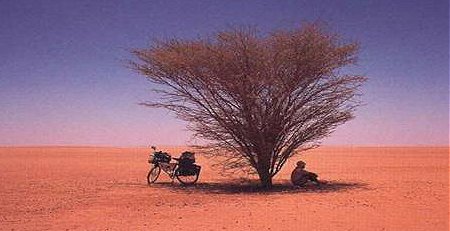
"For my part, I travel not to go anywhere, but to go. I travel for travel's sake. The great affair is to move; to feel the needs and hitches of our life more nearly; to come down off this feather-bed of civilization, and find the globe granite underfoot and strewn with cutting flints." - Robert Louis Stevenson
|
SILK ROAD EXPLORER
Rural Livelihoods Project Phase II - Mongu District, Zambia
PROJECT SUMMARY:
Name of Project: Livelihoods project
Project Location: Mongu District, Western Province, Zambia
Target Population: Direct beneficiaries 245 rural households (approx 1520 people); Indirect target beneficiaries: 32,054 households (162,002 people)
Total Project Cost: $326,092
Target Amount: €20,000
Problem Addressed:
Most remote rural communities in Mongu District do not produce sufficient food from their own farms to sustain themselves for more than 6 months of the year. Few alternative livelihood opportunities are available to them. Lack of support, technical assistance and inappropriate agricultural practices limit their ability to improve their situation. An HIV prevalence rate of around 16 percent has increased livelihood insecurity significantly, fewer able-bodied farmers means less land is cultivated. With very limited resource bases on which to build their lives, people are trapped in poverty. Government and civil society organisations do not have the capacity, neither technical nor logistical, to assist these communities alone.
Project Goal:
To contribute to improved livelihood security in poor rural communities in Mongu District
So far………..
To date, we have raised €1,000 from a table quiz held in O`Dwyers, Mount Street, Dublin. It was a great success. We are in the process of holding another table quiz in Mullingar in the near future. I am also, along with a few friends, running in the Dublin marathon on the 31st of October. All proceeds go to the charity. The venture itself is entirely self-funded.
COUNTRY SITUATION:
The Republic of Zambia embraces 750,614 km2 and borders (clockwise from the north) DRC, Tanzania, Malawi, Mozambique, Zimbabwe, Botswana, Namibia and Angola. With an estimated population of 10.9 million, it is home to more than 70 ethnic groups.
Zambia is one of the world’s poorest and most debt-ridden countries. In 2000 Zambia qualified for debt relief of about $3.8 billion under the enhanced initiative for Highly Indebted Poor Countries (HIPC). The economy has traditionally relied on the mining of copper, cobalt, zinc and lead, but falling copper prices and mismanagement of the mines have increased the country’s dependence on foreign aid – currently accounting for 53% of the budget.
Zambia’s rating of 0.433 on the HDI is not a recent phenomenon; the HDI has been declining since 1985 and at an accelerating rate since 1990. There is clear evidence of an increase in poverty and vulnerability. HIV/AIDS is contributing massively to the reversal of earlier development gains and life expectancy in Zambia has fallen to 37 years. Over 16% of the adult population are living with the HIV virus; as Zambia continues within the ‘mature’ stages of the epidemic, prevalence rates in rural communities can be expected to continue to rise and the number of AIDS related deaths will increase.
The number of orphans is also on the increase and it is estimated that there are 870,000 orphans of which over 60% are AIDS related. 40% of Zambian households are looking after at least one orphan (more commonly 2 or 3) and there are a growing number of ‘child’ and ‘elderly’ headed households who have limited capacity to sustain their own livelihoods. Around 75% of children live below the poverty line.
The burden of the HIV/AIDS epidemic has also impacted on an already struggling health system. Infant mortality rates remain high at 112 per 1,000 live births; under-5 mortality rates have increased to 197 per 1,000 live births and maternal mortality rates are reported to be higher than 870 per 100,000 live births. Access to health facilities remains poor in rural areas; health systems are understaffed and only 64% of the population have a safe water supply.
While 64% of the population earn less than a dollar a day and employment opportunities are scarce, wealth is concentrated in very few hands. 120
Rural women are severely disadvantaged. 77% of women are illiterate and women are twice as likely to be HIV positive compared to men. Traditionally women continue to take on the main role as care givers both to the sick and orphaned children.
To summarise, vulnerability in Zambia is related to:
• The legacy of dependence on copper; reduced Govt income, mismanagement, declining prices, flawed privatization. Previous income provided social services, support to maize prices (distorting agriculture) and a dependency syndrome.
• Increased economic instability, decreasing per capita GDP growth over the last 30 years, increasing poverty and low investment.
• Rapid structural adjustment in the 1990’s.
• Development of a maize dominated agricultural economy in drought prone areas. Since the demise of State marketing, small farmers have been the main losers.
• HIV/AIDS and the increasing numbers of orphans.
• Land tenure reforms have not been implemented, gender based inheritance laws and insecurity of tenure in customary areas.
• The collapse of government services – particularly the veterinary services, leading to the spread of animal diseases, particularly damaging to smallholders in low production drought-prone areas.
• Poor governance and corruption
THE ADVENTURE:
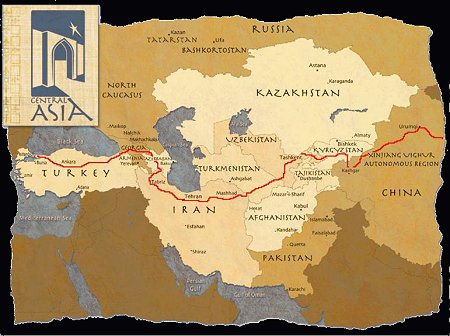
Route of Central Asia in red
|
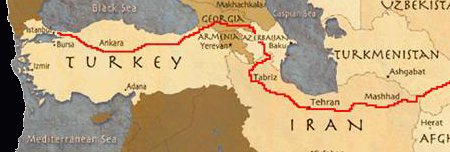
|
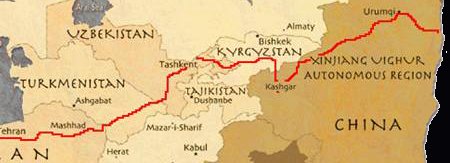
|

Marco Polo
|
The Silk "Road" is a misnomer, for actually it was many roads, many slender filaments originating in thousands of towns and cities all over eastern China. They threaded their way west, skirted the deserts of Turkestan, gradually coalescing into just a handful of trails hacked out of some of the world's most impenetrable mountains. If the bundles of precious silk survived crossing these formidable barriers--the Pamir, the Hindu Kush, and the Karakoram-- they then descended to the Indian Subcontinent. Here the Silk Road swiftly multiplied again, spawning hundreds, then thousands of diverging tracks that brought Chinese goods to Persia, Arabia and Europe, then returned the treasures of those faraway lands to eager Chinese connoisseurs. With so many Silk Roads, then, how is the modern-day traveller to choose?
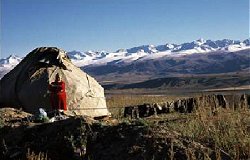
Kyrgyzstan
|
To top it all, within Central Asia lies one of the most inhospitable deserts in the world. Here, there are little or no natural resources. In a land with little water, there is equally little vegetation or wildlife. Sand storms whip the sandy surface of this region burying anything in its path. This is the Taklimakan dessert, but local people call it "the Land of Death", or "the Land of Irrevocable Death". Such people rarely intruded into the interiors of the Taklimakan dessert. Instead they stuck to the path of the Silk Road and other routes which skirted the edges of the dessert. The Taklimakan has for centuries acted as a natural barrier between the East and West; however, it was not the only thing preventing contact.
The land surrounding the Taklimakan is equally hostile. To the northeast lies the Gobi Dessert. This is slightly less dry and desolate than the Taklimakan, but nonetheless a formidable boundary. To the south lie the largest mountain ranges in the world - the Himalayas, Karakourum, and Kunkun. These giants separate Central Asia and the Indian sub-continent. Still another barrier separating east from west is the Pamir "Knot", a conglomeration of several mountain ranges including the Tianshan and Pamir ranges.
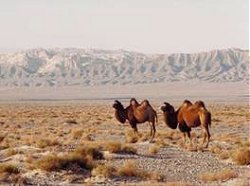
Taklimakan desert
|
The route I have chosen, goes as follows: Ireland to Cherbourg in France, to the Bayern region of Germany around the Alps to Austria, along the Danube to Hungry, through the Carpathian mountains of Romania, Bulgaria to Turkey into the mountainous regions of Georgia, Azerbaijan and Iran, all the way through the Central Asian “Stans”; Turkmenistan, Uzbekistan, Kyrgyzstan, over the Tianshan mountains into the Western province of Xingjing in China, skirting around the inhospitable Taklimakan desert to the ancient capital of the Silk route and home of the famous terracotta warriors, Xian, to finally finish up in Beijing.
As for the logistics of the trip, I hope to cover an estimated 50-100km a day with rest days in between with the journey extending from 8 to 10 months, at an estimated €5,000 for day to day living expenses for the entire journey. I will carry everything that I will need on my bicycle. With regard to accommodation I intend to camp or when possible, to stay with locals of the regions that I will pass through. Food will be prepared on a small gas stove or consist of the local diet.
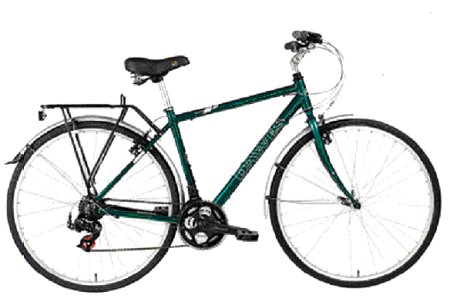
Mojave trek bike, my transport
|
The geography is extremely diverse where the landscape changes from cold wind beaten steppe and blistering hot desert to immense mountain ranges. The highlight of this trip will hopefully be Central Asia, which up to recently, was closed to the West. The majority of the inhabitants of this region still exist as they have done for generations so I hope to observe them before they become too commercialised and “westernised”.
HOW TO CONTACT US:
More information can be found in my website, www.irishchinacycle.com or to contact me at my email, uinnsinn@irishchinacycle.com or phone 086-3412643. This website will contain a diary of the journey, which I will regularly update, giving armchair travellers a chance to follow my adventure.





